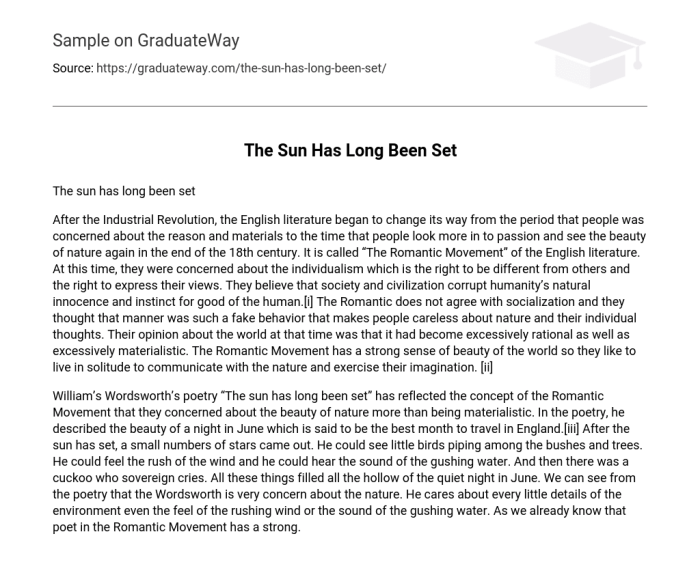The setting sun and the rolling world questions and answers – Embarking on an exploration of the setting sun and the rolling world, this discourse delves into the multifaceted nature of this celestial phenomenon, unraveling its cultural, scientific, artistic, and environmental implications.
From its profound symbolism in literature and art to its astronomical and meteorological underpinnings, the setting sun has captivated the human imagination for centuries. Its cultural significance has permeated societies worldwide, inspiring traditions, rituals, and beliefs that continue to shape our understanding of the world.
The Poetic Symbolism of the Setting Sun: The Setting Sun And The Rolling World Questions And Answers
The setting sun has been a potent symbol in literature and culture for centuries, evoking emotions of change, endings, and reflection. In poetry, the setting sun often represents the passing of time, the end of a day or a life, and the approach of night and darkness.
For example, in William Wordsworth’s “Ode: Intimations of Immortality,” the setting sun symbolizes the loss of innocence and the transition to adulthood.
Examples of Poems Utilizing the Symbolism
- “Sunset”by Emily Dickinson: Explores the themes of death, grief, and the passage of time.
- “The Setting Sun”by Henry Wadsworth Longfellow: Contemplates the end of a day and the beauty of nature’s transitions.
- “The Waste Land”by T.S. Eliot: Uses the setting sun as a metaphor for the decline of civilization and the loss of hope.
The Scientific Explanation of the Setting Sun

Astronomically, the setting sun is the result of the Earth’s rotation on its axis and the position of the sun in relation to the horizon. As the Earth rotates from west to east, the sun appears to move from east to west in the sky.
When the sun reaches the horizon, it appears to set below the horizon due to the curvature of the Earth.
The Role of Earth’s Rotation
The Earth’s rotation causes the sun to appear to move across the sky from east to west. As the Earth rotates, different parts of the planet face the sun, resulting in the cycle of day and night.
The Position of the Sun, The setting sun and the rolling world questions and answers
The sun’s position in relation to the horizon determines when it appears to set. When the sun is at the horizon, it is at its lowest point in the sky and appears to sink below the horizon.
The Cultural Impact of the Setting Sun

The setting sun has played a significant role in various cultures and societies throughout history. In many cultures, the setting sun is associated with the end of the day and the approach of night, often accompanied by traditions, rituals, and beliefs.
Traditions and Rituals
- In some cultures, people gather at sunset to perform rituals or prayers, such as the evening prayer in Islam.
- In other cultures, the setting sun is seen as a time for reflection and meditation, such as in the Japanese tea ceremony.
Beliefs and Symbolism
- In some cultures, the setting sun is believed to represent the departure of the sun god or goddess, often associated with death and rebirth.
- In other cultures, the setting sun is seen as a symbol of hope and renewal, representing the end of one cycle and the beginning of another.
The Artistic Depictions of the Setting Sun

Artists have captured the beauty and significance of the setting sun in various art forms, including paintings, photographs, and other mediums. These depictions often convey the emotions and atmosphere associated with the setting sun, such as peace, tranquility, or nostalgia.
Techniques and Styles
- Painters often use warm colors and soft brushstrokes to depict the golden hues of the setting sun, creating a sense of warmth and serenity.
- Photographers capture the interplay of light and shadow as the sun dips below the horizon, highlighting the dramatic and ethereal qualities of the scene.
Famous Depictions
- “The Scream”by Edvard Munch: Features a vibrant red sky with a setting sun, conveying a sense of anxiety and existential dread.
- “Sunflowers”by Vincent van Gogh: Captures the beauty and vibrancy of the setting sun through the use of bold colors and thick brushstrokes.
The Environmental Impact of the Setting Sun
The setting sun affects the environment in several ways, influencing temperature, light levels, and animal behavior. These changes impact ecosystems and biodiversity.
Temperature Changes
As the sun sets, the Earth’s surface cools due to the reduction in solar radiation. This cooling effect can lead to the formation of dew and fog.
Light Levels
The setting sun provides indirect lighting, which affects the behavior of animals. For example, nocturnal animals become more active as the sun sets, while diurnal animals prepare for sleep.
Animal Behavior
The setting sun cues animals to engage in specific behaviors. For instance, birds may fly back to their nests, while predators become more active as their prey becomes more visible.
FAQ Resource
What is the cultural significance of the setting sun?
In many cultures, the setting sun has been associated with endings, change, and reflection. It has inspired traditions, rituals, and beliefs that vary across different societies.
How does the Earth’s rotation affect the setting sun?
The Earth’s rotation causes the sun to appear to move across the sky. As the Earth rotates, different parts of the planet are exposed to the sun’s light, resulting in the rising and setting of the sun.
What are some artistic techniques used to capture the beauty of the setting sun?
Artists have employed various techniques to convey the emotions and atmosphere associated with the setting sun. These techniques include the use of warm colors, dramatic lighting, and contrasting elements to create a sense of awe and wonder.